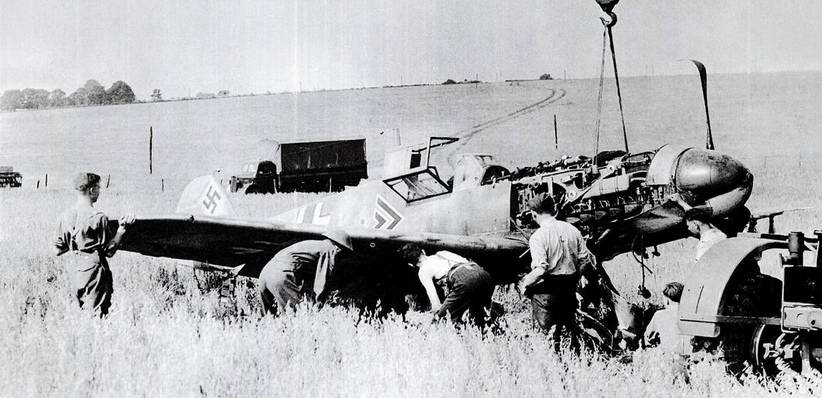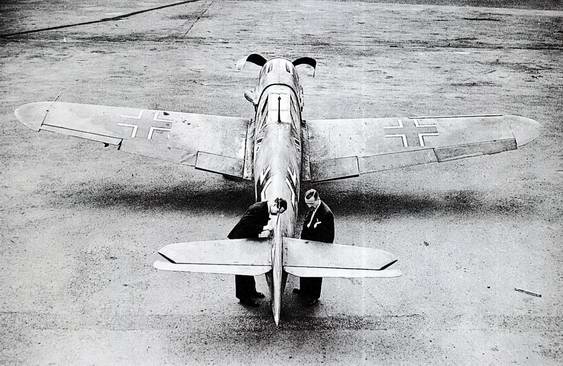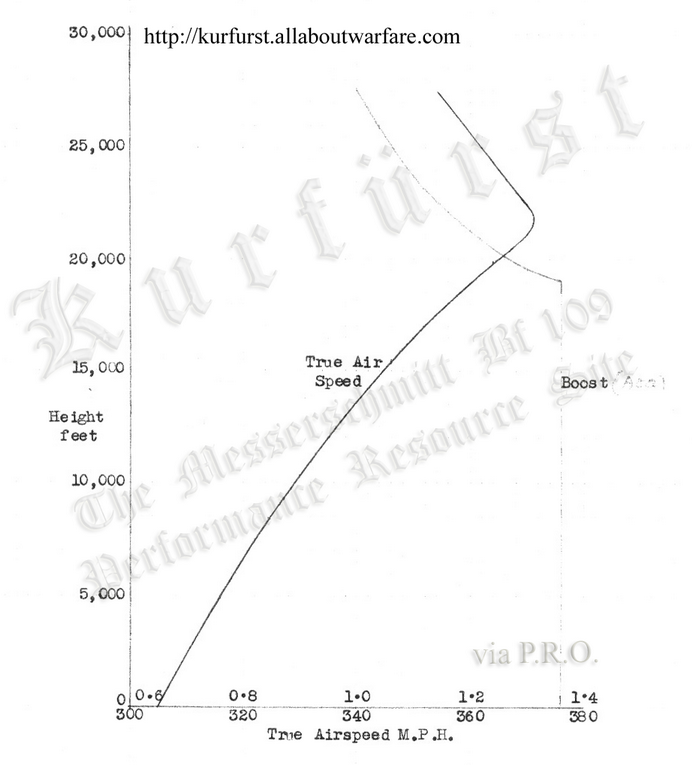S E C R E T
To :-
Headquarters, Fighter Command.
Copy to :- Air Ministry
(D.D.A.T.).
Headquarters, No. 12 Group.
Date :-
28th October 1941
Ref : -
AFDU/3/19/44
TACTICAL TRIALS - Me.109F
AIRCRAFT
a Messerschmitt 109F which forced-landed in this Country on 10th July
1941, was
delivered to this Unit on 11th October 1941, for comperative trials
with full
war load against a Spitfire VB. This aircraft had sustained
some damage and had
been repaired by the R.A.E., Farnborough. Unfortunately the
trials were not
completed as the aircraft was destroyed in a crash nine days after
arrival, but
the following points were foind from the few tests which were carried
out.
Brief Description
(See photograph at Appendix 'A')
2. Externally, the Me.109F is much cleaner than the
Me.109E, altough similiar
in appearance, the main differences being that the airscrew spinner is
much
larger, the wing tips rounded similiar to those of a Spitfire, and the
tailwheel
fully retractable. The tailplane being fully cantilever is
not strutted as on
the Me.109E. The armament is situated in the fuselage and
there is no provision
for fitting of wing guns. The normal full load of the
aircraft is
approximately 6090 lbs.
3. Pilots's
Cocpit. The cocpit is cramped and is only
comfortable for small
pilots. They layout of the instruments and controls is
excellent and is similiar
to that of the Me.109E, with the following exceptions:-
(i) The constant speed airscrew is fully automatic
and requires no operation
by the pilot, as r.p.m. and pitch
setting are governed by the throttle opening
and engine load. This
is a great advantage in combat, being one thing
less for the pilot to worry
about. He can, however, control the pitch
manually in the event of failure
of the automatic control.
(ii) The oil and coolant temperatures are thermostatically
controlled.
(iii) The view forward is rather better than in the Me.109E, but
is still poorer
than in the Spitfire, altough the
straight perspex panels on each side
of the windscreen are preferable
to the curved panels of the Spitfire.
The view to the rear is greatly
restricted by the 9mm. section of armor
plate which protects the pilot's
neck and the back of his head.
Flying Characteristics
4. The controls are well balanced and the aircraft is
pleasant to fly, but is
not so easy to take off as the Me.109E. The elevator
control is fairly heavy
but the rudder control is light and is effective even at low speeds,
the aircraft
being very sensitive to over-correction on the rudder during take-off.
The
Me.109F is not as easy to land as the Spitfire, altough it is a little
easier
than the Me.109E, due to its slightly better forward view.
The speed of approach
for landing is about 110 m.p.h., and the angle is rather steep, which
necessitates
a big change of attitude before the final touch down.
Altough the landing
speed is high, the resultant run is short and brakes can be safely
applied as
soon as the aircraft is on the ground.
Performance
5. The Me.109F is fitted with a Daimler-Benz DB.601N engine
of 1150 h.p., which
is some 150 h.p. more than the DB.601A fitted in the
Me.109E. Trouble was
experienced with the engine of the aircraft under trials owing to low
oil pressure
which limited flying below 20,000 feet. The engine was not
in good condition
and several minor repairs had to be carried out during the brief
trials. It was
possible, however, to obtain the following approximate figures which
should be
treated with reserve:-
Approximate maximum level speeds
1,000 feet - 305 m.p.h., True.
14,600 " - 345 "
"
18,800 " - 362 "
"
The performance figures obtained by R.A.E., Farnborough, are attached as
Appendix
'B'.
Climb and Dive
6. The initial rate of climb and dive is better than that
of the Me.109E and
from the brief trials is considered to be superior to that of the
Spitfire VB.
A graph showing the partial climbs carried out by R.A.E., Farnborough,
is
attached as Appendix
'C'.
Manoeuvrability
7. No manoeuvrability trials were carried out against other
aircraft but the
Me.109F was dived up to 420 m.p.h., I.A.S., with controls trimmed for
level
flight and it was found that altough the elevators had become heavy and
the
ailerons had stiffened up appreciably, fairly tight turns were still
possible.
It is considered, however, that the aircraft could have been out-turned
easily
by a Spitfire. At high speed the ailerons are more
effective than the fabric
ailerons of the Spitfire, but are not as good as the metal
ones. As a result
of the heaviness of the elevators at speeds over 400 m.p.h., violent
evasion is
not possible, and the aircraft would present a simple target to a
following
Spitfire. Similarly, a Spitfire attacked by a Me.109F from
above, should have
no difficulty in evading if he turns sharply towards the direction of
the attack.
It is considered that recovery from a high speed dive near the ground
would be
difficult, as the loss of height entailed is considerable.
This may account
for occasional reports of Me.109F's being seen to dive straight into
the ground
without appearantly being fired at.
Armour
8. The pilot's back is protected by two plates of armour 8
mm. and 6 mm.
thick respectively, and his neck and head are covered by the 9 mm.
curved plate
mentioned in para. 3 above. Additional protection at the
rear is afforded by
the fuel tank which is self-sealing. No bullet-proof
windscreen is fitted, and
the pilot's only protection in front is provided by the engine.
Armament
9. The normal armament of the Me.109F is one 15 mm. or 20
mm. cannon firing
through the airscrew hub and two 7.9 machine guns firing through the
airscrew
dics. The installation appears to be simple and all guns
are easily accessible
for maintaince. This armament differs from that of the
Me.109E, which usually
consists of two 7.9 machine guns firing through the airscre disc, with
a 7.9 mm.
machine gun or 20 mm. cannon in each wing. The probable ammunition
capacities
are as follows: -
Me.109F
2 x 7.9 mm. machine guns - 400/500
rounds per gun.
15 mm. cannon
- 200 rounds.
or
20 mm. cannon - 60
rounds.
Me.109E (a) 4 x 7.9
mm. machine guns - 700 rounds per gun.
(b) 2 x 7.9 mm. machine guns
- 500 rounds per gun.
and
2 x 7.9 mm. machine guns - 500 rounds per gun.
Conclusion
10. The Me.109F, altough very similiar in appearance to the
Me.109E is much
superior in all-round performance. The fac that the
airscrew is fully
automatic, and the oil and coolant temperatures thermostatically
controlled,
helps to make the aircraft a simple fighting machine, as the only
things then
occupying the pilot's attention in combat are his throttle, flying
controls
and guns. The aircraft has a superior initial climb and
dive to that of the
Spitfire, but it is considered that the Spitfire could easily out-turn
the
Me.109F, especially at high speed. The maximum speed of the
aircraft at
18,800 feet is approximately 362 m.p.h., True.
[
signed ]
Wing
Commander,
Commanding, A.F.D.U.
|

 Subseqently, it received rudimentary repairs and the
performance was
tested at R.A.E, then transferred to the A.F.D.U. for tactical trials,
which could not be completed as the aircraft went out of control in a
dive test and crashed. The aircraft bear the designation ES 906 while
being tested in Britain.
Subseqently, it received rudimentary repairs and the
performance was
tested at R.A.E, then transferred to the A.F.D.U. for tactical trials,
which could not be completed as the aircraft went out of control in a
dive test and crashed. The aircraft bear the designation ES 906 while
being tested in Britain.


